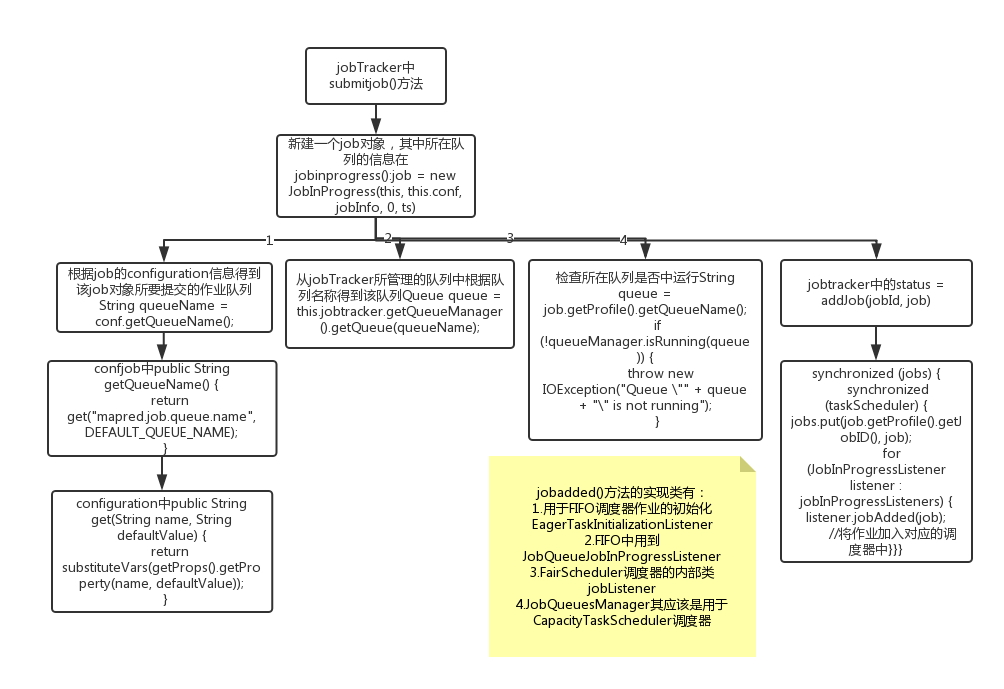- jobtracker自身的main函数如下:
-
 View Code
View Code1 public static void main(String argv[] 2 ) throws IOException, InterruptedException { 3 StringUtils.startupShutdownMessage(JobTracker.class, argv, LOG); 4 5 try { 6 if(argv.length == 0) { 7 JobTracker tracker = startTracker(new JobConf()); 8 tracker.offerService(); 9 } 10 else { 11 if ("-dumpConfiguration".equals(argv[0]) && argv.length == 1) { 12 dumpConfiguration(new PrintWriter(System.out)); 13 } 14 else { 15 System.out.println("usage: JobTracker [-dumpConfiguration]"); 16 System.exit(-1); 17 } 18 } 19 } catch (Throwable e) { 20 LOG.fatal(StringUtils.stringifyException(e)); 21 System.exit(-1); 22 } 23 }
- 主要代码:
- JobTracker tracker = startTracker(new JobConf());
tracker.offerService(); - startTracker()中主要代码如下://创建一个jobTracker对象,并设置调度器
- result = new JobTracker(conf, identifier);
result.taskScheduler.setTaskTrackerManager(result); - offerService()函数中主要的代码:taskScheduler.start();//通过taskScheduler的start方法来启动任务调度器,之后任务调度器就开始调度任务来交给jobTracker执行。当jobClient提交一个job后,jobtracker就通过jobadded(job)方法将提交的job加入job队列中,再进一步初始化,具体参照:jobtracker对提交作业的初始化
- 其中taskScheduler.start()方法中FIFO 调度器代码如下:
- public synchronized void start() throws IOException {
super.start();
taskTrackerManager.addJobInProgressListener(jobQueueJobInProgressListener);//将JobQueueJobInProgressListener加入到jobTracker中的jobInProgressListeners,taskTrackerManager在JobTracker的刚创建的时候就已经设置成jobTracker了,该行就是把实现了JobInProgressListener类的jobQueueJobInProgressListener加入到jobInProgressListeners中,而JobInProgressListener中有一个Map<JobSchedulingInfo, JobInProgress> jobQueue变量,用以存储所有的作业。因为jobQueueJobInProgressListener是被实例化了的,所有存在,实例化是在新建jobTracker对象时设置taskScheduler中完成。语句在jobQueueTaskScheduler的构造函数中: - public JobQueueTaskScheduler() {
this.jobQueueJobInProgressListener = new JobQueueJobInProgressListener();
}
eagerTaskInitializationListener.setTaskTrackerManager(taskTrackerManager);
eagerTaskInitializationListener.start();
taskTrackerManager.addJobInProgressListener(
eagerTaskInitializationListener); }
- //eagerTaskInitializationListener实例化,在QueueTaskScheduler中的Setconf()对象中
 View Code
View Code1 public synchronized void setConf(Configuration conf) { 2 super.setConf(conf); 3 padFraction = conf.getFloat("mapred.jobtracker.taskalloc.capacitypad", 4 0.01f); 5 this.eagerTaskInitializationListener = 6 new EagerTaskInitializationListener(conf); 7 }
而Setconf()函数是在JobTracker实例化中设置Taskscheduler的时候执行的。代码如下:
-
 View Code
View Code1 Class<? extends TaskScheduler> schedulerClass 2 = conf.getClass("mapred.jobtracker.taskScheduler", 3 JobQueueTaskScheduler.class, TaskScheduler.class); 4 taskScheduler = (TaskScheduler) ReflectionUtils.newInstance(schedulerClass, conf);
ReflectionUtils.newInstance(schedulerClass, conf)中的代码如下:
-
 View Code
View Code1 public static <T> T newInstance(Class<T> theClass, Configuration conf) { 2 T result; 3 try { 4 Constructor<T> meth = (Constructor<T>) CONSTRUCTOR_CACHE.get(theClass); 5 if (meth == null) { 6 meth = theClass.getDeclaredConstructor(EMPTY_ARRAY); 7 meth.setAccessible(true); 8 CONSTRUCTOR_CACHE.put(theClass, meth); 9 } 10 result = meth.newInstance();//产生一个TaskScheduler实例 11 } catch (Exception e) { 12 throw new RuntimeException(e); 13 } 14 setConf(result, conf);//执行setConf()方法 15 return result; 16 }
而ReflectionUtils类中的SetConf()方法如下:
-
 View Code
View Code1 public static void setConf(Object theObject, Configuration conf) { 2 if (conf != null) { 3 if (theObject instanceof Configurable) { 4 ((Configurable) theObject).setConf(conf);//TaskScheduler实现类Configurable接口,所以其执行的SetConf()方法是JobQueueTaskScheduler中的SetConf()方法 5 } 6 setJobConf(theObject, conf); 7 } 8 }
- (1)则eagerTaskInitializationListener.start()方法完成的就是:public void start() throws IOException {
this.jobInitManagerThread = new Thread(jobInitManager, "jobInitManager");//产生一个JobInitManager类的线程。
jobInitManagerThread.setDaemon(true);//将该线程设置为守护线程
this.jobInitManagerThread.start();
} - JobInitManager的Run()方法如下: class JobInitManager implements Runnable {
public void run() {
JobInProgress job = null;
while (true) {
try {
synchronized (jobInitQueue) {
while (jobInitQueue.isEmpty()) {
jobInitQueue.wait();//当初始化队列为空时,一直等待
}
job = jobInitQueue.remove(0);//依次移出队列中的对象
}
threadPool.execute(new InitJob(job));//对Job进行初始化,而InitJob()为一个线程class InitJob implements Runnable {
private JobInProgress job; public InitJob(JobInProgress job) { this.job = job; } public void run() { ttm.initJob(job); } }其最后调用的是JobTracker中的InitJob(Job)方法,初始化该Job的所有Tasks等。
} catch (InterruptedException t) {
LOG.info("JobInitManagerThread interrupted.");
break;
}
}
LOG.info("Shutting down thread pool");
threadPool.shutdownNow();
}
} - (2)则其对象就会加入到JobTracker中的JobInProgressListeners中,此时JobInProgressListeners有两个对象,第一个是JobQueueInProgressListener当JobTracker中的Addjob()方法时,其JobAdded(Job)方法是JobQueueJobInProgressListener中的方法,将Job加入到调度队列中:public void jobAdded(JobInProgress job) {
jobQueue.put(new JobSchedulingInfo(job.getStatus()), job);
}
第二个对象是eagerTaskInitializationListener,则其调用的是EagerTaskInitializationListener类中Jobadded(Job)方法:public void jobAdded(JobInProgress job) {
synchronized (jobInitQueue) {
jobInitQueue.add(job);
resortInitQueue();
jobInitQueue.notifyAll();
}
} - (3)之前所说的FairScheduler,CapacityScheduler没有对应的eagerTaskInitializationListener类,则在其对应的jobListener,JobQueuesManager类中必包含了初始化的过程,即哪里一定调用了JobTracker中的InitJob方法

